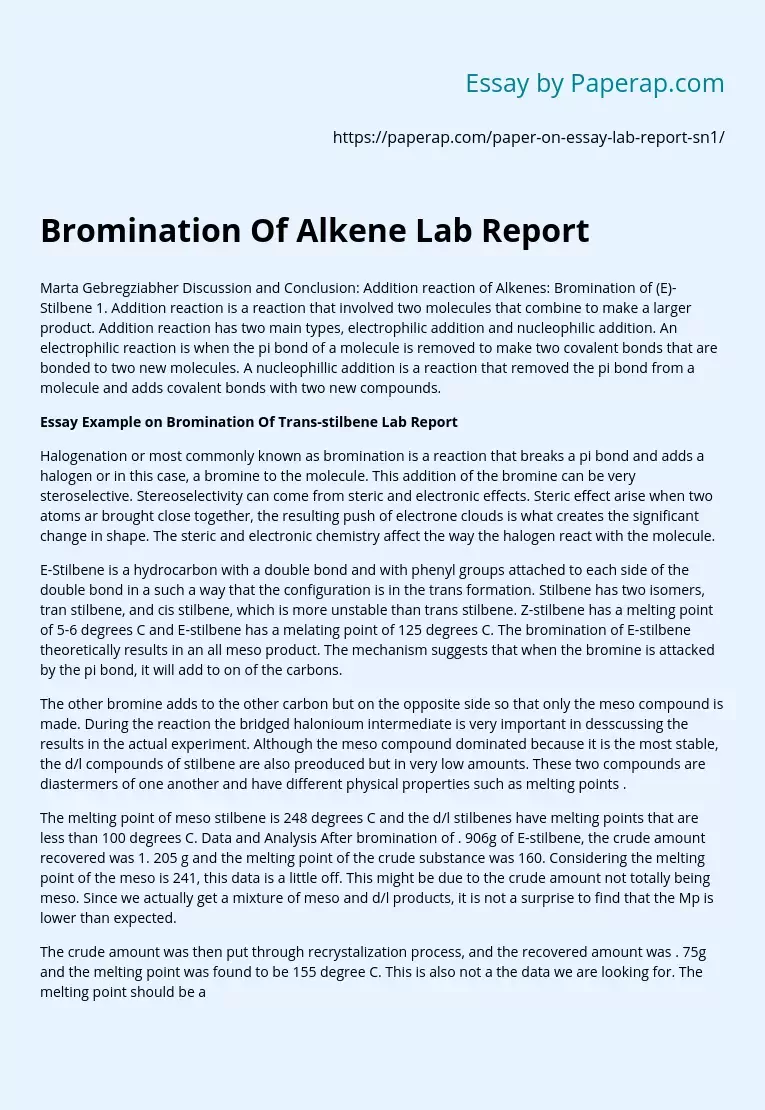Bromination Of Alkene Lab Report
Marta Gebregziabher Discussion and Conclusion: Addition reaction of Alkenes: Bromination of (E)-Stilbene 1. Addition reaction is a reaction that involved two molecules that combine to make a larger product. Addition reaction has two main types, electrophilic addition and nucleophilic addition. An electrophilic reaction is when the pi bond of a molecule is removed to make two covalent bonds that are bonded to two new molecules. A nucleophillic addition is a reaction that removed the pi bond from a molecule and adds covalent bonds with two new compounds.
Essay Example on Bromination Of Trans-stilbene Lab Report
Halogenation or most commonly known as bromination is a reaction that breaks a pi bond and adds a halogen or in this case, a bromine to the molecule. This addition of the bromine can be very steroselective. Stereoselectivity can come from steric and electronic effects. Steric effect arise when two atoms ar brought close together, the resulting push of electrone clouds is what creates the significant change in shape.
The steric and electronic chemistry affect the way the halogen react with the molecule.
E-Stilbene is a hydrocarbon with a double bond and with phenyl groups attached to each side of the double bond in a such a way that the configuration is in the trans formation. Stilbene has two isomers, tran stilbene, and cis stilbene, which is more unstable than trans stilbene. Z-stilbene has a melting point of 5-6 degrees C and E-stilbene has a melating point of 125 degrees C. The bromination of E-stilbene theoretically results in an all meso product.
The mechanism suggests that when the bromine is attacked by the pi bond, it will add to on of the carbons.
The other bromine adds to the other carbon but on the opposite side so that only the meso compound is made. During the reaction the bridged halonioum intermediate is very important in desscussing the results in the actual experiment. Although the meso compound dominated because it is the most stable, the d/l compounds of stilbene are also preoduced but in very low amounts. These two compounds are diastermers of one another and have different physical properties such as melting points .
The melting point of meso stilbene is 248 degrees C and the d/l stilbenes have melting points that are less than 100 degrees C. Data and Analysis After bromination of . 906g of E-stilbene, the crude amount recovered was 1. 205 g and the melting point of the crude substance was 160. Considering the melting point of the meso is 241, this data is a little off. This might be due to the crude amount not totally being meso. Since we actually get a mixture of meso and d/l products, it is not a surprise to find that the Mp is lower than expected.
The crude amount was then put through recrystalization process, and the recovered amount was . 75g and the melting point was found to be 155 degree C. This is also not a the data we are looking for. The melting point should be a combination of two melting points for the meso product and the d/l product. So the melting point we want should be around 180 degree C. The fact that its lower could be that all the contaminants have not been removed from the recoved amount and that was hindering the accuracy of the data.
Also maybe the reaction did not finish producing all the meso compounds so that led to a significant decrease in melting point. The % yield of the product was 82. 78%. some sources of error could that after stiring for 15 mins some of the solids was left in the round bottom flask and there was no way to get all of it out. Also another source of error could be when removing the stir bar, some of the product stuck onto the stir bar and there was a loss of product from there.
As well as when recrystalizing, some of the solid was left on the beaker, when it was being transferred to a weighing boat for a final weighing. Conclusion Purpose of the experiament was to add bromine to e-stilbene to get z-stilbene. Although the theoretical data states that all of the product should be meso, the actual experiament says otherwise and we get a mixture of meso, and d/l products. Although most of the product is meso, the intermediate was stereoselective enough to produce d/l products too.
Bromination Of Alkene Lab Report. (2019, Nov 27). Retrieved from https://paperap.com/paper-on-essay-lab-report-sn1/

